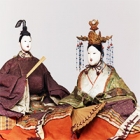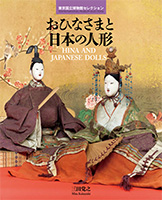本館 14室
2016年3月1日(火) ~ 2016年4月10日(日)
3月3日は桃の節句(せっく)。華やかで楽しいおひなさまの季節です。おひなさまの歴史は、古代の人びとが罪や穢(けが)れを託して水に流したヒトガタや、平安時代から幼児のお守りとして貴族が用いた天児(あまがつ)・這子(ほうこ)に遡ります。また平安貴族の子どもたちは小さな人形を使って「ひいな遊び」というオママゴトを行なっていました。
祈りを託し、時に一緒に遊ぶという人形のあり方は江戸時代に引き継がれ、女の子のため桃の節句におひなさまを飾る風習が定着します。初期の雛(ひな)人形は紙製の立雛(たちびな)であったと考えられ、いまだ手遊(てあそ)びの要素が強いものでした。
17世紀の前半には宮中の特別な誂(あつら)えとして絹の衣裳(いしょう)を着た座雛(すわりびな)が登場し、武家(ぶけ)や町方(まちかた)にも広まります。特に富裕な町方では錦や金襴(きんらん)をふんだんに用いた元禄雛(げんろくびな)や古今雛(こきんびな)など、華麗な人形が生み出されました。
この特集ではこうした歴史をたどる様々な雛人形を展示します。中でも、ご注目いただきたいのは、当館の雛人形を代表する牙首雛(げくびびな)と古今雛で、特に頭や手足を象牙(ぞうげ)で作った牙首雛とセットの紫宸殿(ししんでん)はクリーニング作業を終えて、初公開となります。
また宮廷や大名家などで愛され、その優れた造形性から日本の人形文化を代表する御所人形(ごしょにんぎょう)についても、当館が所蔵する名品を一同に展示します。これらの作品を通じ、繊細で美しく、そして可愛らしいものを尊ぶ日本の美意識を感じていただければ幸いです。


